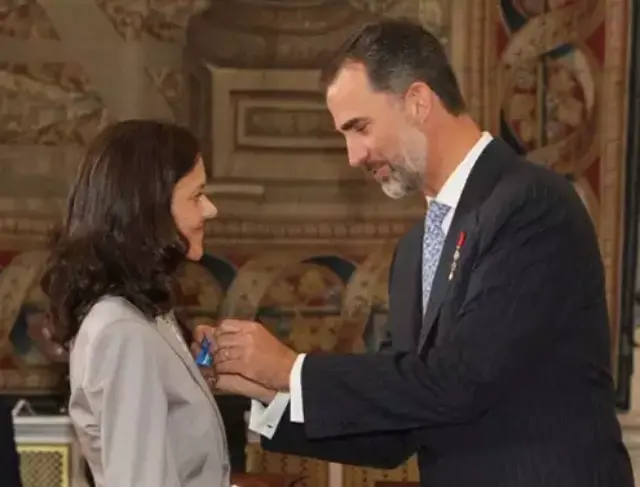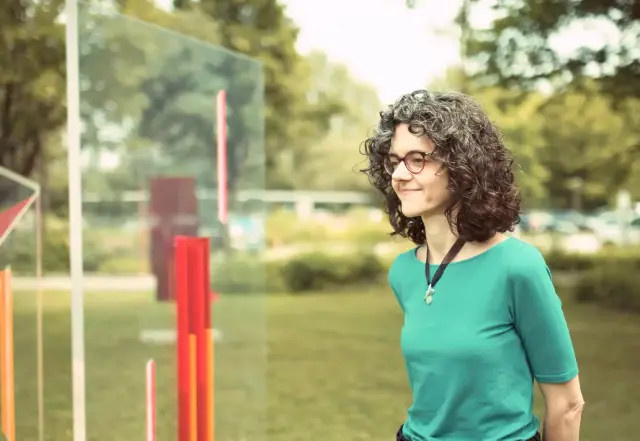21 August 2024
The holy grail of algorithms
Mari Carmen Bañuls is a physicist and a computer scientist. Her scientific career began in particle physics. At the Max Planck Institute of Quantum Optics, she now develops algorithms for quantum simulations.
Mari Carmen Bañuls is a physicist and a computer scientist. Her career started in Valencia, Spain, with a fascination for particle physics, leading her to computer science and finally to the Max Planck Institute of Quantum Optics. Here, she is now a group leader in the “Theory” department and works on the development of algorithms for simulating complex quantum systems. Driven by curiosity and openness, Bañuls emphasizes the importance of teamwork and exchange within the scientific community. To encourage this, she is involved both as a mentor for doctoral students and for the institute as a whole.
Mari Carmen Bañuls is a modest person. It is almost impossible to elicit any immodesty from her in conversation. For example, take the case of the "Orden del Merito Civil". In 2015, King Juan Felipe of Spain awarded this medal to 38 Spanish citizens in recognition of their services to the Spanish nation. One of those honoured was physicist and computer scientist Bañuls.

Mari Carmen Bañuls has been researching at the Max Planck Institute of Quantum Optics in Garching for 19 years. Here she is a group leader in Ignacio Cirac's "Theory" department. Bañuls discovered her love of physics at school and therefore decided to study this discipline in her home town of Valencia. Particle physics was her initial focus: "The professors' lectures on this subject simply inspired me," she says, "and as a young person, you often do what your teachers inspire you to do."
From particle physics to quantum physics
Then as now, she was particularly fascinated by one phenomenon: Quantum entanglement, i.e. the direct effect of quanta on each other, even when they are spatially separated. "This relationship between the parts of a quantum system is completely counterintuitive," says Bañuls, "but it has dramatically real effects on the results of local experiments." This phenomenon is one of the reasons why quantum systems are incredibly complex; so complex that they can only be understood in part using existing methods. Scientists are therefore feverishly researching new algorithms with which quantum systems can be simulated reasonably realistically. Spoiler alert: Mari Carmen Bañuls is working on developing such algorithms at the Max Planck Institute in Garching. But it has been a 30-year journey until then. During this time, she has often been able to demonstrate her curiosity and her ability to familiarise herself with completely new specialist areas at the highest level.

Tensor networks: simulating complex systems in small segments
With both – particle physics and computer science – the Spaniard had all the knowledge and techniques she needed to embark on the search for her personal holy grail: an algorithm with which complex quantum systems can be simulated better than before. The tool that she is constantly developing and optimising for this purpose are so-called tensor networks. Tensor networks are a mathematical method by which certain aspects or states of complex systems can be picked out from the totality of all possible states in order to better describe, simulate and understand them as examples for the entire system.
To the layperson, it may sound surprising that Bañuls sees tensor networks as something closer to application than, for instance, particle physics. But the 50-year-old is good at explaining it: She cites high-temperature superconductors as an example. Normal superconductors conduct electricity without loss at temperatures close to absolute zero (minus 273°C). High-temperature superconductors "only" need around minus 140°C to demonstrate superconductivity. "With superconductors, thanks to theoretical models and conventional simulations, we understand quite well what happens inside them and how the electrons behave," says Bañuls: "With high-temperature superconductors, the conditions are too complex. We need new methods for this."
Tracing the secrets of quantum systems
Tensor networks make it possible to observe precisely defined states of electron systems and to answer specific questions relating to these states. This brings physicists a step closer to the secrets of high-temperature superconductivity. The same applies to quantum systems, such as those on which quantum computers are based. With tensor networks, researchers like Bañuls can "look at individual families of states of the qubits", as she says. The group leader from the Theory department is particularly interested in the temporal dynamics in which these states evolve – and thus ultimately determine the computing power and computing results of quantum computers.

Commitment to the scientific community and to the team
Listening to Bañuls, you get the impression that she sees herself more as a member of a large scientific group than as a group leader. So she was also the Ombud Person at the institute for many years, a confidential go-to contact in questions relating to scientific misconduct. Bañuls explains her commitment with the belief that "you also have to give something back to the institute”.

Source: MPQ Website